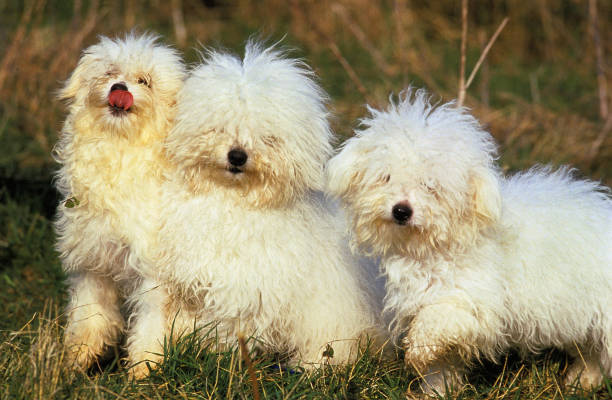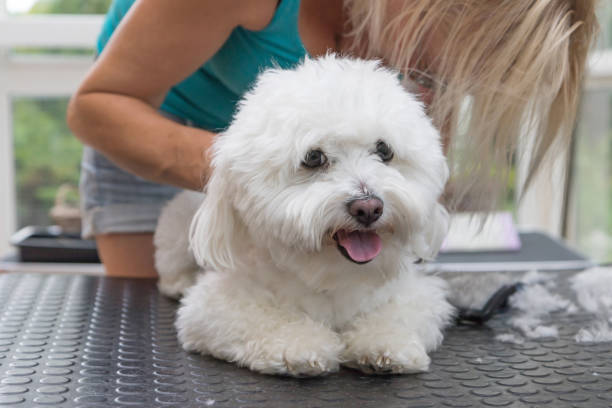Bolognese

Breed History:
The Bolognese dog is named after the Italian city of Bologna, where it was cherished for centuries by nobility and aristocrats. This small, white companion breed descends from the ancient bichon family and has roots tracing back to Roman times, prized for its affectionate nature and charming appearance.
Favoured by European royalty, including Catherine the Great and Empress Maria Theresa, the Bolognese became known as a “gift dog,” often exchanged among nobles as a token of esteem. Its fluffy, cotton-like coat, which doesn’t shed, suited life indoors, while its calm, intelligent temperament made it an ideal lapdog and loyal companion.
|
Gender |
Height |
Weight |
|
Male |
27-30 cm |
2-4 kg |
|
Female |
25-28 cm |
2-4 kg |
Size – Small
Life Expectancy: 14 years

Breed Appearance:
The Bolognese dog is a small, fluffy breed known for its charming, cotton-like coat and affectionate nature. Its long, white fur, often described as soft and silky, requires regular care to keep it free from tangles and mats. Unlike other toy breeds with coarse coats, the Bolognese's hair grows continuously, giving it a regal, cloud-like appearance.
With a rounded head, dark, expressive eyes, and a slightly lifted tail, the Bolognese exudes a calm and gentle presence. Its compact, sturdy body is balanced by its graceful movements, which are often described as light and fluid.
Breed Type - Family/guard:
The Bolognese dog is a calm, affectionate breed known for its loyal and gentle nature. It is typically social and enjoys being close to its family, forming strong bonds with its owners. While not overly energetic, it thrives on attention and companionship, often seeking to be the center of family life. Though friendly, Bolognese dogs may be reserved with strangers, making them excellent watchdogs without being aggressive.
Despite their small size, Bolognese dogs are intelligent and eager to please, which makes training relatively easy when done with patience and consistency. They require moderate exercise, such as short walks, and enjoy a comfortable environment where they can interact with their loved ones. They are generally quiet dogs, making them well-suited for apartment living or calm households.

Training:
The Bolognese dog is an intelligent and eager-to-please breed, though it can be somewhat independent at times. They tend to respond well to positive reinforcement, such as praise and treats, which makes training relatively straightforward for most owners. While they enjoy learning new tasks, Bolognese dogs may become distracted if the training lacks variety or engagement, so it’s important to keep sessions fun and stimulating.
These dogs are quick learners and can master basic commands, but they thrive best in a consistent, patient environment. Bolognese dogs respond well to gentle training methods, as they are sensitive and bond closely with their family. They are more motivated by companionship and a harmonious relationship than by external rewards, making mutual trust and respect essential for success in training.
Health & Care:
The Bolognese dog is generally a healthy breed with a lifespan that tends to be longer than that of many other small dogs, often reaching 12-14 years or more. However, they can still be susceptible to certain health conditions, including patellar luxation, which affects the knees, and dental issues due to their small mouth structure. Regular dental care is essential for maintaining oral health.
Like many small breeds, the Bolognese may also experience skin conditions, especially given their long, soft coat, which requires regular grooming to prevent matting and tangling. Their diet should be carefully managed to maintain a healthy weight, as they can be prone to obesity if overfed.

Living Conditions:
Originally bred for companionship and lapdog duties among European nobility, the Bolognese dog is now best suited to homes that provide warmth, comfort, and a steady routine. While they can adapt well to apartment living due to their small size, they thrive in environments where they can be close to their family members and enjoy consistent attention. They do well in homes with calm, predictable surroundings and prefer being indoors, where they can snuggle and bond with their owners.
Bolognese dogs require moderate daily exercise, such as short walks and playtime, and enjoy mental stimulation in the form of interaction with their humans. While they are sociable and affectionate, they also appreciate quiet time alone. Their long, soft coat requires regular grooming, and they should be kept in warm environments, as they are sensitive to extreme cold.
Exercise:
Like all dogs, the Bolognese dog requires regular exercise to stay healthy, though their activity needs are moderate compared to more high-energy breeds. Daily walks, combined with some playtime, are usually sufficient to keep them physically fit and mentally engaged. While they may not have the stamina for long, intense exercise sessions, they do enjoy short bursts of play and interactive activities that involve their family members.
Though not known for high-intensity games like fetch, Bolognese dogs thrive on mentally stimulating tasks such as puzzle toys or basic training exercises. Their exercise routine should focus on low-impact activities that engage their mind and maintain their small, sturdy body. By balancing physical movement with cognitive challenges, owners can ensure their Bolognese stays both healthy and happy.
Grooming:
The Bolognese dog’s soft, long coat requires regular grooming to keep it looking its best and prevent matting. Daily brushing is recommended to remove tangles and maintain the coat’s fluffy, cotton-like texture, particularly around the ears, legs, and under the armpits. Their coat is less prone to shedding, but it still needs attention to keep it clean and healthy.
Bathing should be done every few weeks or as necessary, using a gentle, hypoallergenic dog shampoo to protect their sensitive skin. Regular ear cleaning is also important to prevent infections, as their ears can trap moisture. Nail trimming is essential to avoid discomfort, and regular checks for skin irritations or parasites should be part of the grooming routine. Additionally, brushing their teeth a few times a week will help maintain good dental health, ensuring the Bolognese stays healthy and comfortable.

Advantages:
-
Charming and fluffy appearance with a gentle, affectionate nature
-
Loyal and devoted to family, enjoys close companionship
-
Quiet and calm—rarely barks, making it well-suited for apartment living
-
Great with children and other pets when properly socialised
-
Easy to manage in smaller spaces with regular exercise
-
Enjoys indoor lounging but can be active with play or short walks
Disadvantages:
-
Regular grooming is required to prevent matting and maintain the coat
-
Can be independent and sometimes stubborn, making training a bit challenging
-
Susceptible to dental and joint issues, such as patellar luxation
-
Not as energetic as other breeds, which may not suit active owners
-
Sensitive to heat and cold due to their small size and thin coat
-
Requires consistent care and attention to maintain overall health and well-being

